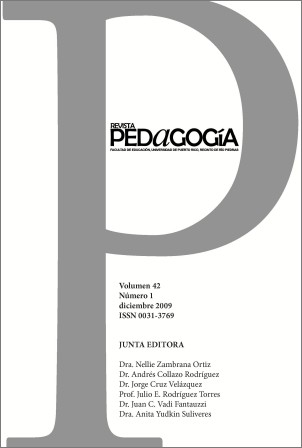Résumé
Este estudio exploratorio examinó la validez de los resultados obtenidos mediante la administración de la Beery VMI a una muestra de niños puertorriqueños. El proceso incluyó la traducción de las instrucciones de la prueba, entrevistas a cuatro profesionales que utilizan la prueba y la administración de la prueba a 50 estudiantes de Kindergarten de dos escuelas de San Juan, Puerto Rico. Los datos cuantitativos y cualitativos se recopilaron a base de los Estándares para las Pruebas Educativas y Psicológicas (1999): contenido, proceso de respuesta, estructura interna, relación con otras variables y consecuencias de la prueba. La información respecto al contenido, el proceso de respuesta y las consecuencias de la prueba apoyaron la validez de los resultados. Sin embargo, se deben realizar otros estudios para establecer una conclusión definitiva.
Cómo citar:
Román-Oyola, R., & Bonilla-Rodríguez, V. E. (2011). Beery-Buktenica Visual Motor Integration Test: Validity evidence examination. Pedagogía, 42(1), 193-222. Recuperado a partir de https://revistas.upr.edu/index.php/educacion/article/view/16671
Références
Allen, M., & Yen, W. (2002). Introduction to measurement theory (2nd ed.). Long Grove, IL: Waveland Press. American Educational Research Association, American Psychological
Association, & National Council of Measurement in Education. (1999). Standards for educational and psychological testing. Washington, DC: American Psychological Association.
Beery, K., & Beery, N. (2004). The Beery-Buktenica Developmental Test of Visual-Motor Integration: Administration, scoring and teaching manual (5thed.). Minneapolis, MN: NCS Pearson.
Bonilla-Landrón, M. (2002). La lectoescritura en preescolares con y sin rezago en el desarrollo y el aprendizaje: Discursos y prácticas de dos maestras de Kindergarten. Unpublished master‘s thesis, Universidad de Puerto Rico, Río Piedras, Puerto Rico.
Braverman, M. T., & Slater, J. K. (1996). Advances in survey research: New directions for evaluation. San Francisco, CA: Jossey-Bass.
Case-Smith, J. (2002). Effectiveness of school-based occupational therapy intervention on handwriting. American Journal of Occupational Therapy, 56 (1), 17-25.
Christiansen, C., & Lou, J. (2001). Ethical considerations related to evidencebased practice. American Journal of Occupational Therapy, 55 (3), 354-349.
Creswell, J. (2005). Educational research: Planning, conducting and evaluating quantitative and qualitative research (2nd ed.). Upper Saddle River, NJ: Merill-Prentice Hall.
Cornhill, H., & Case-Smith, J. (1996). Factors that relate to good and poor handwriting. American Journal of Occupational Therapy, 50(9), 732-739.
Cohen, J. (1988). Statistical power analysis for the behavioral sciences (2nded.). Hillsdale, NJ: Lawrence Erlbaum Associates.
Crano, W., & Brewer, M. (1973). Principles of research in social psychology. New York: McGraw-Hill.
Daly, C., Kelley, T., & Krauss, A. (2003). Relationship between visual motor integration and handwriting skills of children in Kindergarten: A modified replication study. American Journal of Occupational Therapy, 57(4), 459-462.
Fowler, F. J. (2002). Survey research methods (3rd ed.). Thousand Oaks, CA: Sage Publications.
Frey, P., & Pinelli, B. Jr. (1991). Visual discrimination and visuomotor integration among two classes of Brazilian children. Perceptual and motor skills, 72, 847-850.
Gorsuch, R. (1983). Factor analysis (2nd ed.). Hillsdale, NJ: Lawrence Erlbaum Associates.
Grissom, R. J., & Kim, J. J. (2005). Effect sizes for research: A broad practical approach. Mahwah, NJ: Lawrence Erlbaum Associates.
Hinkle, D., Wiersma, W., & Jurs, S. (2003). Applied statistics for the behavioral sciences (5th ed.). Boston, MA: Houghton Mifflin Company.
Hsu, H. (1997). Performance of primary school children in Taiwan on the Beery Developmental Test of Visual-Motor Integration (China). Unpublished master‘s thesis, University of Southern California, California, United States.
Institute of Phonetic Sciences, Amsterdam. (1996). Two correlation coefficients [Web service]. Retrieved August 29, 2006 from http://www.fon.hum.uva.nl/Service/Statistics/Two_Correlations.html
Kulp, M., & Sortor, J. (2003). Clinical value of the Beery Visual-Motor Integration Supplemental Tests of visual perception and motor coordination. Optometry and Vision Science, 80(4), 312-315.
Marr, D., Windsor, M., & Cermak, S. (2001). Handwriting readiness: Locatives and visualmotor skills in the Kindergarten year. Utica, NY: Early Childhood Research & Practice: An Internet Journal on the Development, Care and Education of Young Children. (ERIC Document Reproduction Service No. ED452998)
Marriott, G. (2000). Developmental differences in visual-motor integration in children from 4 to 6- years-old on the Kindergarten Diagnostic InstrumentSecond edition. Unpublished doctoral dissertation, Texas Woman‘s University, Texas, United States.
McHale, K., & Cermark, S. (1992). Fine motor activities in elementary school: Preliminary findings and provisional implications for children with fine motor problems. American Journal of Occupational Therapy, 46(10), 898- 903.
McMillan, J. (2004). Educational research: Fundamentals for the consumer (4th ed.). Boston, MA: Pearson Education.
Messick, S. (1989). Meaning and values in test validation: The sciences and ethics of assessment. Educational Researcher, 18(2), 5-11.
Portney, L., & Watkins, M. (2000). Foundations of clinical research: Applications to practice (2nd ed.). Upper Saddle River, NJ: Prentice Hall Health.
Richardson, P. (2001). Use of standardized test in pediatric practice. In J. Case-Smith (Ed.), Occupational therapy for children (pp. 217-245). Saint Louis, MO: Elsevier Science.
Stevens, J. (2001). Applied multivariate statistics for the social sciences (4ht ed.). Hillsdale, NJ: Lawrence Erlbaum Associates.
Tabachnick, B., & Fidell, L. (2007). Using multivariate statistics (5th ed.). Boston, MA: Pearson Allyn & Bacon.
Tseng, M., & Murray, E. (1994). Differences in perceptual-motor measures in children with good and poor handwriting. Occupational Therapy Journal of Research, 14 (1), 19-36.
Verdonck, M. C., & Henneberg, M. (1997). Manual dexterity of South African children growing in contrasting socioeconomic conditions. American Journal of Occupational Therapy, 51, 303-306.
Weintraub, N., & Graham, S. (2000). The contribution of gender, orthographic, finger function, and visual-motor processes to the prediction on handwriting status. Occupational Therapy Journal of Research, 20(2), 321-34.

Ce travail est disponible sous licence Creative Commons Attribution - Pas d’Utilisation Commerciale 4.0 International.

